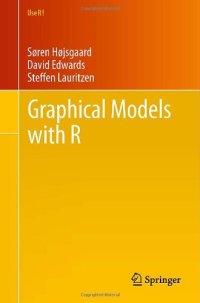
Ebook: Graphical Models with R
- Genre: Mathematics // Mathematicsematical Statistics
- Tags: Statistical Theory and Methods, Statistics general
- Series: Use R!
- Year: 2012
- Publisher: Springer-Verlag New York
- Edition: 1
- Language: English
- pdf
Graphical models in their modern form have been around since the late 1970s and appear today in many areas of the sciences. Along with the ongoing developments of graphical models, a number of different graphical modeling software programs have been written over the years. In recent years many of these software developments have taken place within the R community, either in the form of new packages or by providing an R interface to existing software. This book attempts to give the reader a gentle introduction to graphical modeling using R and the main features of some of these packages. In addition, the book provides examples of how more advanced aspects of graphical modeling can be represented and handled within R. Topics covered in the seven chapters include graphical models for contingency tables, Gaussian and mixed graphical models, Bayesian networks and modeling high dimensional data.
Graphical models in their modern form have been around since the late 1970s and appear today in many areas of the sciences. Along with the ongoing developments of graphical models, a number of different graphical modeling software programs have been written over the years. In recent years many of these software developments have taken place within the R community, either in the form of new packages or by providing an R interface to existing software. This book attempts to give the reader a gentle introduction to graphical modeling using R and the main features of some of these packages. In addition, the book provides examples of how more advanced aspects of graphical modeling can be represented and handled within R. Topics covered in the seven chapters include graphical models for contingency tables, Gaussian and mixed graphical models, Bayesian networks and modeling high dimensional data. Table of Contents Cover Graphical Models with R ISBN 9781461422983 e-ISBN 9781461422990 Preface Contents Chapter 1: Graphs and Conditional Independence 1.1 Introduction 1.2 Graphs 1.2.1 Undirected Graphs 1.2.2 Directed Acyclic Graphs 1.2.3 Mixed Graphs 1.3 Conditional Independence and Graphs 1.4 More About Graphs 1.4.1 Special Properties 1.4.2 Graph Layout in Rgraphviz 1.4.3 The igraph Package 1.4.4 3-D Graphs 1.4.5 Alternative Graph Representations 1.4.6 Operations on Graphs in Different Representations Chapter 2: Log-Linear Models 2.1 Introduction 2.2 Preliminaries 2.2.1 Four Datasets 2.2.2 Data Formats o As a Raw Case-List o As an Aggregated Case-List o As a Contingency Table 2.3 Log-Linear Models 2.3.1 Preliminaries and Notation 2.3.2 Hierarchical Log-Linear Models 2.3.3 Graphical and Decomposable Log-Linear Models 2.3.4 Estimation, Likelihood, and Model Fitting 2.3.5 Hypothesis Testing 2.4 Model Selection 2.5 Further Topics 2.5.1 Fitting Log-Linear Models with glm() 2.5.2 Working with dModel Objects 2.6 Various Chapter 3: Bayesian Networks 3.1 Introduction 3.1.1 The Chest Clinic Example 3.1.2 Models Based on Directed Acyclic Graphs 3.1.3 Inference 3.2 Building and Using Bayesian Networks 3.2.1 Specification of Conditional Probability Tables 3.2.2 Building the Network o 3.2.2.1 Compilation-Finding the Clique Potentials o 3.2.2.2 Propagation-from Clique Potentials to Clique Marginals 3.2.3 Absorbing Evidence and Answering Queries 3.3 Further Topics 3.3.1 Building a Network from Data 3.3.2 Bayesian Networks with RHugin 3.3.3 Simulation 3.3.4 Prediction 3.3.5 Working with HUGIN Files 3.4 Learning Bayesian Networks Chapter 4: Gaussian Graphical Models 4.1 Introduction 4.2 Some Examples 4.2.1 Carcass Data 4.2.2 Body Fat Data 4.3 Undirected Gaussian Graphical Models 4.3.1 Preliminaries and Notation 4.3.2 Estimation, Likelihood, and Model Fitting 4.3.3 Hypothesis Testing 4.3.4 Concentration and Regression 4.3.5 Decomposition of UGGMs 4.4 Model Selection 4.4.1 Stepwise Methods 4.4.2 Convex Optimization 4.4.3 Thresholding 4.4.4 Simultaneous p-Values 4.4.5 Summary of Models 4.5 Directed Gaussian Graphical Models 4.5.1 Markov Equivalence 4.6 Model Selection for DGGMs 4.6.1 The PC Algorithm 4.6.2 Alternative Methods for Identifying DGGMs o 4.6.2.1 Greedy Search o 4.6.2.2 A Hybrid Algorithm 4.7 Gaussian Chain Graph Models 4.7.1 Selecting a Chain Graph Model 4.8 Various Chapter 5: Mixed Interaction Models 5.1 Introduction 5.2 Example Datasets 5.3 Mixed Data and CG-densities 5.4 Homogeneous Mixed Interaction Models 5.5 Model Formulae 5.6 Graphical and Decomposable MI-models 5.7 Maximum Likelihood Estimation 5.7.1 Likelihood and Deviance 5.7.2 Dimension of MI-models 5.7.3 Inference 5.7.4 Likelihood Equations 5.7.5 Iterative Proportional Scaling o 5.7.5.1 Weak Marginals o 5.7.5.2 Likelihood Equations Revisited o 5.7.5.3 General IPS Update Step o 5.7.5.4 Step-Halving Variant o 5.7.5.5 Mixed Parameterisation Variant 5.8 Using gRim 5.8.1 Updating Models 5.8.2 Inference 5.8.3 Stepwise Model Selection 5.9 An Example of Chain Graph Modelling 5.10 Various Chapter 6: Graphical Models for Complex Stochastic Systems 6.1 Introduction 6.2 Bayesian Graphical Models 6.2.1 Simple Repeated Sampling 6.2.2 Models Based on Directed Acyclic Graphs 6.3 Inference Based on Probability Propagation 6.4 Computations Using Monte Carlo Methods 6.4.1 Metropolis-Hastings and the Gibbs Sampler 6.4.2 Using WinBUGS via R2WinBUGS 6.5 Various Chapter 7: High Dimensional Modelling 7.1 Introduction 7.2 Two Datasets 7.3 Computational Efficiency 7.4 The Extended Chow-Liu Algorithm 7.5 Decomposable Stepwise Search 7.6 Selection by Approximation 7.7 Finding MAP Forests References Index